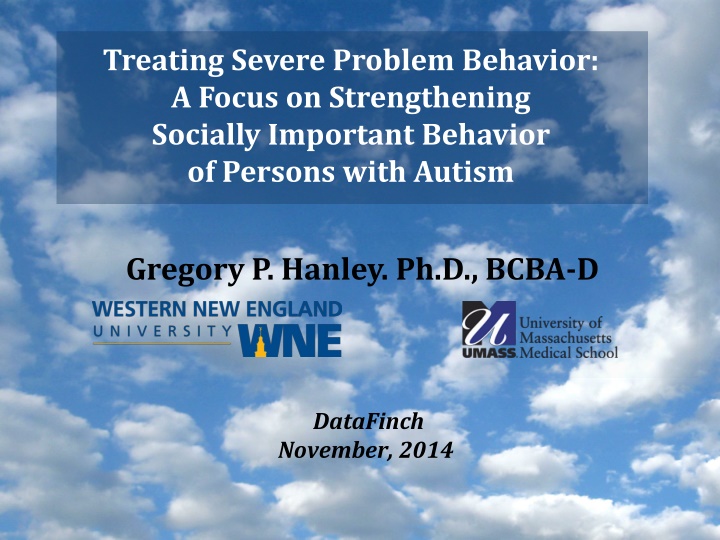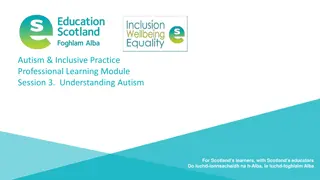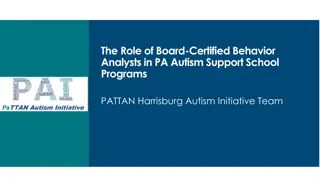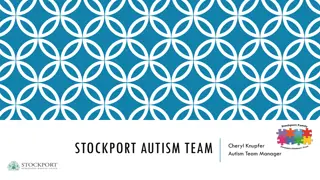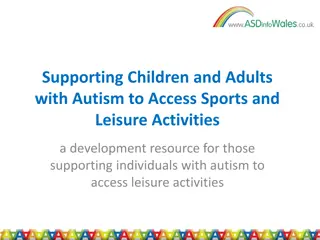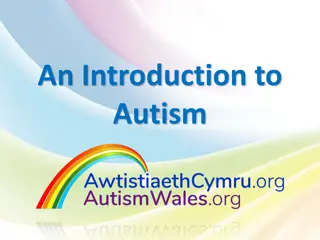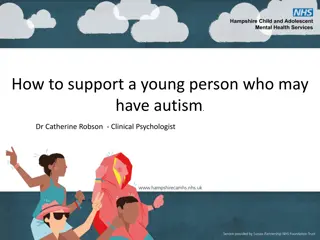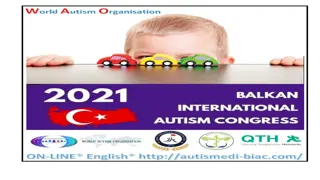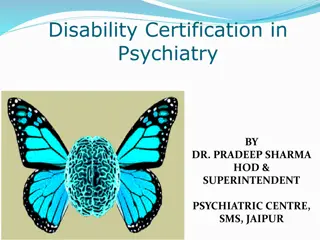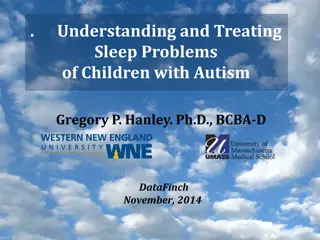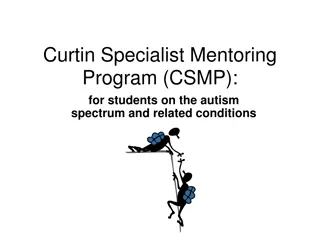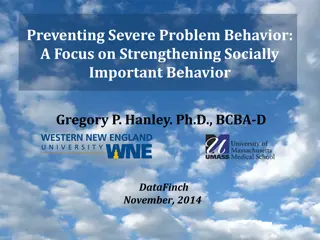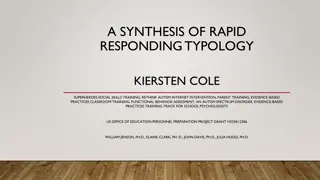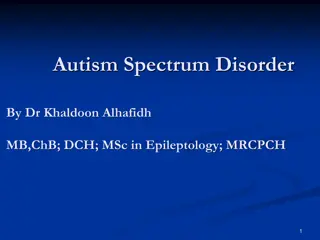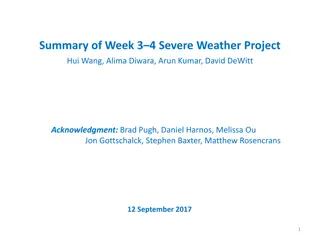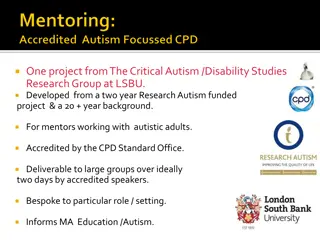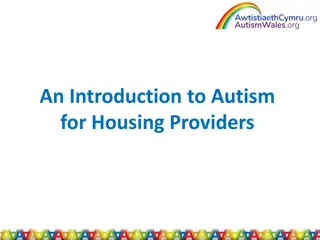Treating Severe Problem Behavior in Autism: A Focus on Strengthening Socially Important Behavior
This document discusses a treatment approach for severe problem behavior in individuals with autism, focusing on enhancing socially significant behaviors. It outlines a Functional Assessment and Treatment Model with steps like Functional Analysis, Communication Training, Response Chaining, and Treatment Extension. The Treatment Analysis section delves into Denial Behavior, Tolerance Training, and reinforcement strategies for a boy diagnosed with autism. Various sessions and visits are recorded along with response levels and compliance percentages.
Download Presentation

Please find below an Image/Link to download the presentation.
The content on the website is provided AS IS for your information and personal use only. It may not be sold, licensed, or shared on other websites without obtaining consent from the author.If you encounter any issues during the download, it is possible that the publisher has removed the file from their server.
You are allowed to download the files provided on this website for personal or commercial use, subject to the condition that they are used lawfully. All files are the property of their respective owners.
The content on the website is provided AS IS for your information and personal use only. It may not be sold, licensed, or shared on other websites without obtaining consent from the author.
E N D
Presentation Transcript
Treating Severe Problem Behavior: A Focus on Strengthening Socially Important Behavior of Persons with Autism Gregory P. Hanley. Ph.D., BCBA-D DataFinch November, 2014
Functional Assessment and Treatment Model Steps (expanded) Interview 1 Functional Analysis 2 Functional Communication Training 3 Complex FCT 4 Tolerance Response Training 5 Easy Response Chaining 6 Difficult Response Chaining 7 Treatment Extension 8
Treatment Analysis Denial BL Denial and Delay Tolerance Training BL FCT + EXT 14 Complex FCR Simple FCR Problem Behavior 12 10 per min Dale 8 6 Treatment Extension 4 2 11-year old boy 0 4 Simple FCR 3 per min diagnosed with Autism 2 1 0 2.0 Complex FCR 1.5 per min 1.0 0.5 0.0 2.0 Tolerance Response 1.5 per min 1.0 0.5 0.0 Sessions 100 Reinforcement 75 1 2 3 4 5 6 7 8 9 10 11 12 13 14 15 16 17 18 19 20 21 22 23 24 25 26 27 28 29 30 31 Visits 2/28 3/1 (%) Dale 4/24 50 1/24 1/25 1/30 1/31 2/12 2/15 2/22 2/26 3/13 3/20 3/24 3/27 3/29 4/10 4/11 4/12 4/19 4/26 2/1 2/5 2/6 3/5 3/6 3/8 4/2 4/3 4/5 5/2 25 Calendar Days (2013) 0 100 Instructions (%) Response to 75 Noncomp. Compliance 50 1 Levels 2 3 25 0 10 20 30 40 50 60 70 80 90 100 Sessions 1 2 3 4 5 6 7 8 9 10 11 12 13 14 15 16 17 18 19 20 21 22 23 24 25 26 27 28 29 30 31 Visits 2/28 3/1 1/24 1/25 1/30 1/31 2/12 2/15 2/22 2/26 3/13 3/20 3/24 3/27 3/29 4/10 4/11 4/12 4/19 4/24 4/26 2/1 2/5 2/6 3/5 3/6 3/8 4/2 4/3 4/5 5/2 Calendar Days (2013)
Denial BL Treatment Analysis Denial and Delay Tolerance Training BL FCT + EXT 14 Complex FCR Simple FCR Problem Behavior 12 10 per min 8 6 Dale Treatment Extension 4 2 0 11-year old boy 4 Simple FCR 3 per min 2 diagnosed with Autism 1 0 2.0 Complex FCR 1.5 per min 1.0 0.5 0.0 2.0 Tolerance Response 1.5 per min 1.0 0.5 0.0 Sessions 100 Reinforcement 75 1 2 3 4 5 6 7 8 9 10 11 12 13 14 15 16 17 18 19 20 21 22 23 24 25 26 27 28 29 30 31 Visits 2/28 3/1 (%) Dale 4/24 50 1/24 1/25 1/30 1/31 2/12 2/15 2/22 2/26 3/13 3/20 3/24 3/27 3/29 4/10 4/11 4/12 4/19 4/26 2/1 2/5 2/6 3/5 3/6 3/8 4/2 4/3 4/5 5/2 Calendar Days (2013) 25 0 100 Instructions (%) Response to 75 Noncomp. Compliance 50 1 Levels 2 3 25 0 10 20 30 40 50 60 70 80 90 100 Sessions 1 2 3 4 5 6 7 8 9 10 11 12 13 14 15 16 17 18 19 20 21 22 23 24 25 26 27 28 29 30 31 Visits 2/28 3/1 1/24 1/25 1/30 1/31 2/12 2/15 2/22 2/26 3/13 3/20 3/24 3/27 3/29 4/10 4/11 4/12 4/19 4/24 4/26 2/1 2/5 2/6 3/5 3/6 3/8 4/2 4/3 4/5 5/2 Calendar Days (2013)
Denial BL Treatment Analysis Denial and Delay Tolerance Training BL FCT + EXT 14 Complex FCR Simple FCR Problem Behavior 12 10 per min 8 6 Dale Treatment Extension 4 2 0 11-year old boy 4 Simple FCR 3 per min 2 diagnosed with Autism 1 0 2.0 Complex FCR 1.5 per min 1.0 0.5 0.0 2.0 Tolerance Response 1.5 per min 1.0 0.5 0.0 Sessions 100 Reinforcement 75 1 2 3 4 5 6 7 8 9 10 11 12 13 14 15 16 17 18 19 20 21 22 23 24 25 26 27 28 29 30 31 Visits 2/28 3/1 (%) Dale 4/24 50 1/24 1/25 1/30 1/31 2/12 2/15 2/22 2/26 3/13 3/20 3/24 3/27 3/29 4/10 4/11 4/12 4/19 4/26 2/1 2/5 2/6 3/5 3/6 3/8 4/2 4/3 4/5 5/2 Calendar Days (2013) 25 0 100 Instructions (%) Response to 75 Noncomp. Compliance 50 1 Levels 2 3 25 0 10 20 30 40 50 60 70 80 90 100 Sessions 1 2 3 4 5 6 7 8 9 10 11 12 13 14 15 16 17 18 19 20 21 22 23 24 25 26 27 28 29 30 31 Visits 2/28 3/1 1/24 1/25 1/30 1/31 2/12 2/15 2/22 2/26 3/13 3/20 3/24 3/27 3/29 4/10 4/11 4/12 4/19 4/24 4/26 2/1 2/5 2/6 3/5 3/6 3/8 4/2 4/3 4/5 5/2 Calendar Days (2013)
Denial BL Denial and Delay Tolerance Training BL FCT + EXT 14 Complex FCR Simple FCR Problem Behavior 12 10 per min 8 6 Treatment Extension 4 2 0 4 Simple FCR 3 per min 2 1 0 2.0 Complex FCR 1.5 per min 1.0 0.5 0.0 2.0 Tolerance Response 1.5 per min 1.0 Treatment Analysis 0.5 Denial BL Denial and Delay Tolerance Training BL FCT + EXT 0.0 100 Reinforcement 75 Dale (%) Dale 50 11-year old boy 25 0 100 Instructions (%) Response to 75 diagnosed with Autism Noncomp. Compliance 50 1 Levels 2 3 25 0 10 20 30 40 50 60 70 80 90 100 Sessions 1 2 3 4 5 6 7 8 9 10 11 12 13 14 15 16 17 18 19 20 21 22 23 24 25 26 27 28 29 30 31 Visits 2/28 3/1 1/24 1/25 1/30 1/31 2/12 2/15 2/22 2/26 3/13 3/20 3/24 3/27 3/29 4/10 4/11 4/12 4/19 4/24 4/26 2/1 2/5 2/6 3/5 3/6 3/8 4/2 4/3 4/5 5/2 Calendar Days (2013)
Denial BL Treatment Analysis Denial and Delay Tolerance Training BL FCT + EXT 14 Complex FCR Simple FCR Problem Behavior 12 10 per min 8 6 Dale Treatment Extension 4 2 0 11-year old boy 4 Simple FCR 3 per min 2 diagnosed with Autism 1 0 2.0 Complex FCR 1.5 per min 1.0 0.5 0.0 2.0 Tolerance Response 1.5 per min 1.0 0.5 0.0 Sessions 100 Reinforcement 75 1 2 3 4 5 6 7 8 9 10 11 12 13 14 15 16 17 18 19 20 21 22 23 24 25 26 27 28 29 30 31 Visits 2/28 3/1 (%) Dale 4/24 50 1/24 1/25 1/30 1/31 2/12 2/15 2/22 2/26 3/13 3/20 3/24 3/27 3/29 4/10 4/11 4/12 4/19 4/26 2/1 2/5 2/6 3/5 3/6 3/8 4/2 4/3 4/5 5/2 Calendar Days (2013) 25 0 100 Instructions (%) Response to 75 Noncomp. Compliance 50 1 Levels 2 3 25 0 10 20 30 40 50 60 70 80 90 100 Sessions 1 2 3 4 5 6 7 8 9 10 11 12 13 14 15 16 17 18 19 20 21 22 23 24 25 26 27 28 29 30 31 Visits 2/28 3/1 1/24 1/25 1/30 1/31 2/12 2/15 2/22 2/26 3/13 3/20 3/24 3/27 3/29 4/10 4/11 4/12 4/19 4/24 4/26 2/1 2/5 2/6 3/5 3/6 3/8 4/2 4/3 4/5 5/2 Calendar Days (2013)
Denial BL Denial and Delay Tolerance Training BL FCT + EXT 14 Complex FCR Simple FCR Problem Behavior 12 10 per min 8 6 Treatment Extension 4 2 0 4 Simple FCR 3 per min 2 1 0 2.0 Complex FCR 1.5 per min 1.0 0.5 0.0 2.0 Tolerance Response 1.5 per min 1.0 0.5 Denial BL Treatment Analysis Denial and Delay Tolerance Training BL FCT + EXT 0.0 100 Reinforcement 75 (%) Dale Dale 50 25 11-year old boy 0 100 Instructions (%) Response to 75 Noncomp. Compliance 50 diagnosed with Autism 1 Levels 2 3 25 0 10 20 30 40 50 60 70 80 90 100 Sessions 1 2 3 4 5 6 7 8 9 10 11 12 13 14 15 16 17 18 19 20 21 22 23 24 25 26 27 28 29 30 31 Visits 2/28 3/1 1/24 1/25 1/30 1/31 2/12 2/15 2/22 2/26 3/13 3/20 3/24 3/27 3/29 4/10 4/11 4/12 4/19 4/24 4/26 2/1 2/5 2/6 3/5 3/6 3/8 4/2 4/3 4/5 5/2 Calendar Days (2013) Levels Walk over here, stand up, sit down, clap your hands, touch your (shoulder, head, toes) Draw a circle, write your name, copy what I write Unzip your backpack, take out the book, erase the board come to the board, put these books on the book shelf Read this paragraph, Answer this question ., Sound out the words Solve this (addition, subtraction etc ) Wash your hands, do this chore (e.g., organizing chairs) Throw or kick the ball 1 Simple motor movements 2 Simple academics Homework/Task preparation 3 Complex academic: Reading skills Complex academic: Math skills Self-help skills Play skills
Denial BL Treatment Analysis Denial and Delay Tolerance Training BL FCT + EXT 14 Complex FCR Simple FCR Problem Behavior 12 Response Chaining 10 per min 8 6 Dale Treatment Extension 4 2 * 0 11-year old boy 4 Simple FCR 3 per min 2 diagnosed with Autism 1 0 2.0 Complex FCR 1.5 per min 1.0 0.5 0.0 2.0 Tolerance Response 1.5 per min 1.0 0.5 0.0 Sessions 100 Reinforcement 75 1 2 3 4 5 6 7 8 9 10 11 12 13 14 15 16 17 18 19 20 21 22 23 24 25 26 27 28 29 30 31 Visits 2/28 3/1 (%) Dale 4/26 5/2 50 1/24 1/25 1/30 1/31 2/12 2/15 2/22 2/26 3/13 3/20 3/24 3/27 3/29 4/10 4/11 4/12 4/19 4/24 2/1 2/5 2/6 3/5 3/6 3/8 4/2 4/3 4/5 Calendar Days (2013) 25 0 100 Instructions (%) Response to 75 Noncomp. Compliance 50 1 Levels 2 3 25 0 10 20 30 40 50 60 70 80 90 100 Sessions 2 3 4 5 6 7 8 9 10 11 12 13 14 15 16 17 18 19 20 21 22 23 24 25 26 27 28 29 30 31 32 Visits 2/28 3/1 1/24 1/25 1/30 1/31 2/12 2/15 2/22 2/26 3/13 3/20 3/24 3/27 3/29 4/10 4/11 4/12 4/19 4/24 4/26 2/1 2/5 2/6 3/5 3/6 3/8 4/2 4/3 4/5 5/2 Calendar Days (2013)
Denial BL Treatment Analysis Denial and Delay Tolerance Training BL FCT + EXT 14 Complex FCR Simple FCR Problem Behavior 12 Response Chaining 10 per min 8 6 Dale Treatment Extension 4 2 * 0 11-year old boy 4 Simple FCR 3 per min 2 diagnosed with Autism 1 0 2.0 Complex FCR 1.5 per min 1.0 0.5 0.0 2.0 Tolerance Response 1.5 per min 1.0 0.5 0.0 Sessions 100 Reinforcement 75 1 2 3 4 5 6 7 8 9 10 11 12 13 14 15 16 17 18 19 20 21 22 23 24 25 26 27 28 29 30 31 Visits 2/28 3/1 (%) Dale 4/26 5/2 50 1/24 1/25 1/30 1/31 2/12 2/15 2/22 2/26 3/13 3/20 3/24 3/27 3/29 4/10 4/11 4/12 4/19 4/24 2/1 2/5 2/6 3/5 3/6 3/8 4/2 4/3 4/5 Calendar Days (2013) 25 0 100 Instructions (%) Response to 75 Noncomp. Compliance 50 1 Levels 2 3 25 0 10 20 30 40 50 60 70 80 90 100 Sessions 2 3 4 5 6 7 8 9 10 11 12 13 14 15 16 17 18 19 20 21 22 23 24 25 26 27 28 29 30 31 32 Visits 2/28 3/1 1/24 1/25 1/30 1/31 2/12 2/15 2/22 2/26 3/13 3/20 3/24 3/27 3/29 4/10 4/11 4/12 4/19 4/24 4/26 2/1 2/5 2/6 3/5 3/6 3/8 4/2 4/3 4/5 5/2 Calendar Days (2013)
Denial BL Denial and Delay Tolerance Training BL FCT + EXT 14 Complex FCR Simple FCR Problem Behavior 12 10 per min 8 6 Treatment Extension 4 2 0 4 Simple FCR 3 per min 2 1 0 2.0 Complex FCR 1.5 per min 1.0 0.5 0.0 2.0 Tolerance Response 1.5 per min 1.0 0.5 Denial BL Treatment Analysis Denial and Delay Tolerance Training BL FCT + EXT 0.0 100 Treatment Extension Reinforcement 75 (%) Dale Dale 50 25 11-year old boy 0 100 Instructions (%) Response to 75 Noncomp. Compliance 50 diagnosed with Autism 1 Levels 2 3 25 0 10 20 30 40 50 60 70 80 90 100 Sessions 1 2 3 4 5 6 7 8 9 10 11 12 13 14 15 16 17 18 19 20 21 22 23 24 25 26 27 28 29 30 31 Visits 2/28 3/1 1/24 1/25 1/30 1/31 2/12 2/15 2/22 2/26 3/13 3/20 3/24 3/27 3/29 4/10 4/11 4/12 4/19 4/24 4/26 2/1 2/5 2/6 3/5 3/6 3/8 4/2 4/3 4/5 5/2 Calendar Days (2013) Three analysts alternated while parents observed the sessions Following training, the father was introduced after the analyst presented the evocative trial and halfway through the session; the mother was present in the session room The mother implemented treatment in the session room Parents varied the type and amount of instructions during the delay period Parents implemented treatment in the home while novel instructions were introduced
# of Visits (1 hr each) Cost Steps (in US dollars) Range Mean Range Mean 1* Interview -- 1 -- 200 2* Functional Analysis 1 - 4 2.3 166 - 800 467 Functional Communication Training 3 1 - 3 2 200 - 534 400 4 Complex FCT 1 - 4 2.4 200 - 860 487 Tolerance Response Training 5 2 - 7 4.6 300 - 1400 913 6 Easy Response Chaining 1 - 5 2.6 200 960 520 7* Difficult Response Chaining 2 - 11 5.1 400 - 2240 1,013 8* Treatment Extension 4 - 9 7.3 800 - 1800 1,467 Totals: 23 - 32 27 5,467 Supervision meetings: 16 - 28 20 1000 - 1750 1250 Report writing / planning: -- 4 -- 500 Grand Totals: 6225 - 8650 7,217
Time Assessment # of Visits (1 hr each) Cost Steps (in US dollars) Range Mean Range Mean 1* Interview -- 1 -- 200 2* Functional Analysis 1 - 4 2.3 166 - 800 467 Functional Communication Training 3 1 - 3 2 200 - 534 400 4 Complex FCT 1 - 4 2.4 200 - 860 487 Tolerance Response Training 5 2 - 7 4.6 300 - 1400 913 6 Easy Response Chaining 1 - 5 2.6 200 960 520 7* Difficult Response Chaining 2 - 11 5.1 400 - 2240 1,013 8* Treatment Extension 4 - 9 7.3 800 - 1800 1,467 Totals: 23 - 32 27 5,467 Supervision meetings: 16 - 28 20 1000 - 1750 1250 Report writing / planning: -- 4 -- 500 Grand Totals: 6225 - 8650 7,217
Cost Assessment # of Visits (1 hr each) Cost Steps (in US dollars) Range Mean Range Mean 1* Interview -- 1 -- 200 2* Functional Analysis 1 - 4 2.3 166 - 800 467 Functional Communication Training 3 1 - 3 2 200 - 534 400 4 Complex FCT 1 - 4 2.4 200 - 860 487 Tolerance Response Training 5 2 - 7 4.6 300 - 1400 913 6 Easy Response Chaining 1 - 5 2.6 200 960 520 7* Difficult Response Chaining 2 - 11 5.1 400 - 2240 1,013 8* Treatment Extension 4 - 9 7.3 800 - 1800 1,467 Totals: 23 - 32 27 5,467 Supervision meetings: 16 - 28 20 1000 - 1750 1250 Report writing / planning: -- 4 -- 500 Grand Totals: 6225 - 8650 7,217
General Social Validity Data Social Acceptability Questionnaire Results Ratings Questions Gail Dale Bob Mean 1. Acceptability of assessment procedures 7 7 7 7 2. Acceptability of treatment packages 3. Satisfaction with improvement in problem behavior 4. Helpfulness of consultation 7 7 7 7 7 7 7 6 7 7 6.7 7 Note. 7=highly acceptable, highly satisfied, or very helpful 1=not acceptable, not satisfied, or not helpful
Personalized Social validity Data Parents' Comfort Level of Presenting the Evocative Situation Comfort Levels Questions Pre-treatment Post-treatment Gail 1. Taking away toys 2. Telling child "no" when they ask for something 3. Giving instructions Dale 1 3 5 7 7 7 1. Interrupting child's preferred activity and telling them to do homework or other non-preferred activities 4 6 Bob 1. Taking away DS or iPad at meal times 2. Taking away DS or iPad on a transition 3. Interrupting or correcting math work Note. 7=very comfortable 1=not comfortable. 3 3 3 7 7 7
Some open-ended responses from the Social Acceptability Questionnaire
Implications If the problem behavior occurs with regularity, it is being reinforced Solution involves four main steps: 1. Identify the reinforcing contingency for the problem behavior 2. Replace problem behavior by providing the functional reinforcer for socially acceptable alternatives 3. Teach child to tolerate (intermittent and unpredictable)periods when the reinforcer is unavailable 4. Extend treatment to relevant people and contexts
Ten Unique Aspects of our Approach (continued) 7. Our function-based treatments are always skill-based Published in Behavior Analysis in Practice in 2008 (available for free at PubMed Central)
Ten Unique Aspects of our Approach 8. We always increase the complexity, flexibility, and/or interactional nature of the FCR before teaching delay/denial tolerance Simple FCR: ( My way or My way, please ) Complex FCR: Excuse me After a second or two, Yes, Billy May I have my way, please? Will you play my way, please? After a second or two, Sure, Billy
Ten Unique Aspects of our Approach 9. We always explicitly teach delay/denial tolerance This takes up most of our time with children and families (not the functional assessment or teaching the FCRs) First teach an explicit response to a variety of disappointment signals, then to make treatment practical: Chain important behavior to the tolerance response (there is always a progressive component a gradual increase in time, stakes, or both)
With only Progressive Reinforcement Delay: As delay increases, FCR weakens & probability of PB increases
Time-based vs. Contingency-based Progressive Delay (Lead Author: Mahshid Ghaemmaghami) 10 TBPD (with EXT) CBPD (with EXT) No Delay No Delay Terminal Delay (no EXT) No Delay Problem Behavior 8 per min 6 4 Alex 2 0 10 20 30 40 1.8 Responses per min Sessions Ind TR Ind FCR 1.2 0.6 0.0 10 20 30 40 Scheduled Delay Mean Experienced Delay Sessions
Time-Based Progressive Delay No Delay Contingency-Based Progressive Delay (CBPD) No Delay 5 100 Time-based vs. Contingency-based Progressive Delay (Lead Author: Mahshid Ghaemmaghami) % of Session Engaged in 80 4 Emotional Responding Context 1 60 3 Problem Behavior 40 2 20 1 per min 0 0 3 100 CBPD No Delay Terminal Delay Without Extinction No Delay Terminal Delay Without Extinction 80 2 60 Context 2 40 1 20 0 0 4 100 % of Delay Interval Engaged in Context 1 80 Appropriate Responses 3 60 Alternative Activity 2 40 1 20 per min 0 0 3 100 Context 2 80 FCR Tolerance Response 2 60 40 1 20 0 0 400 300 Scheduled Experienced Duration of Delay (s) Context 1 200 100 0 400 Context 2 300 200 Jack 100 0 5 10 15 20 25 30 35 40 45 50 55 Sessions Figure 1. Results of the comparison between time-based progressive delay and contingency-based progressive delay for Jack.
Time-Based Progressive Delay No Delay Contingency-Based Progressive Delay (CBPD) No Delay 5 100 Time-based vs. Contingency-based Progressive Delay (Lead Author: Mahshid Ghaemmaghami) % of Session Engaged in 80 4 Emotional Responding Context 1 60 3 Problem Behavior 40 2 20 1 per min 0 0 3 100 CBPD No Delay Terminal Delay Without Extinction No Delay Terminal Delay Without Extinction 80 2 60 Context 2 40 1 20 0 0 4 100 % of Delay Interval Engaged in Context 1 80 Appropriate Responses 3 60 Alternative Activity 2 40 1 20 per min 0 0 3 100 Context 2 80 FCR Tolerance Response 2 60 40 1 20 0 0 400 300 Scheduled Experienced Duration of Delay (s) Context 1 200 100 0 400 Context 2 300 200 Jack 100 0 5 10 15 20 25 30 35 40 45 50 55 Sessions Figure 1. Results of the comparison between time-based progressive delay and contingency-based progressive delay for Jack.
5 Critical Aspects of Delay/Denial Tolerance Training 1. Always provide immediate sr for some FCRs 2. Teach an appropriate response to multiple cues of delay, denial, or disappointment 3. Progressively increase the average amount of behavior (not just time) required to terminate the delay 4. Terminate the delay for various amounts of behavior (sometimes expect very little behavior sometimes request larger or more complex types of behavior during the delay) 5. Probably best to not signal how much behavior is required to terminate the delays
Ten Unique Aspects of our Approach 10. We work hard to ensure that the process is agreeable and outcome is meaningful to both children and parents Have parents witness and take part in the entire process Keep working with child until the wish list goal is met (e.g., going to Six Flags as a family)
Please share this Take-Home Point Autism is not a life sentence of: Meltdowns Aggression Self-injury
Freedom from these problem behaviors is possible and probable with: BCBA-led, objective analysis Skill-based treatments yielding functional reinforcers Contingency-based delay tolerance procedures
